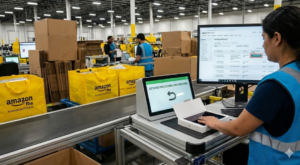
What Amazon Sellers should brace for after Trump's inauguration? Higher tariffs, disrupted supply chains, increased import costs, and more.
The political changes following President Trump’s inauguration create significant shifts in the e-commerce world, particularly for Amazon sellers. As tariffs rise, supply chains are disrupted, and new regulations take shape, sellers grapple with higher costs and greater uncertainty.
These challenges, including unpredictable trade policies, complicated tax laws, and staffing shortages, require swift adaptation.
In this article, we break down the key issues Amazon sellers should brace for and offer actionable insights to prepare for the future of e-commerce.
Trump's Inauguration and Amazon's Contribution
Amazon played a notable role in President Donald Trump’s inauguration. According to Fox Business, a growing list of influential tech industry executives, including Amazon’s CEO Jeff Bezos, attended the inauguration, reflecting the sector’s increasing political and economic influence.
In addition to Bezos, other notable tech figures such as Meta’s Mark Zuckerberg, Apple’s Tim Cook, and Google’s Sundar Pichai were also expected at the event.
Amazon also made significant contributions to the inaugural festivities. As reported by USA Today, Amazon donated $1 million to President Trump’s inaugural fund and provided another $1 million through in-kind support by airing the event on its Prime Video service.
This donation aligns Amazon with other major tech companies, like Meta Platforms, which also contributed $1 million to the inauguration fund.
What time is the inauguration on TV?
President-elect Donald Trump’s inauguration, which also coincided with Dr. Martin Luther King Jr. Day, took place at 12 p.m. EST inside the U.S. Capitol Rotunda, due to cold weather, as reported by NPR.
It was also available for streaming on platforms like Disney+, Hulu, Roku, and Amazon Fire TV. Replays should be available on various channels.
What Amazon Sellers Should Brace for in E-commerce
In our previous post, we identified major areas that Amazon sellers need to be concerned with as we look at the potential impact of Trump’s presidency on the e-commerce landscape. Sellers should brace for several changes:
- Tariffs could raise import costs, forcing price hikes, which may reduce demand.
- Higher tariffs may require diversifying suppliers, leading to more complex logistics and delays.
- Price-sensitive consumers may resist price increases, pressuring sellers to absorb costs.
- Increased scrutiny could bring changes to fees, visibility, and competitive dynamics.
- Evolving labor and environmental rules could affect Amazon’s operations, potentially improving fulfillment efficiency.
Keep reading to find out the latest updates and how you can adapt your Amazon business to these changes.
What Amazon Sellers Should Brace For: TikTok Ban
TikTok is now accessible in the United States once more, but its continued availability will likely depend on the decisions of President Donald Trump, as reported by CNN.
TikTok’s uncertain future in the U.S. poses a challenge for Amazon sellers who rely on the platform for marketing and sales. Here’s how to navigate this situation:
What TikTok is to Amazon Sellers
- Promotion & Engagement
TikTok is a powerful tool for promoting products and engaging directly with consumers.
- TikTok Shop
A growing alternative to Amazon, offering lower fees and a simpler selling process.
- Shift in Seller Activity
With a decline in Amazon sellers, many are turning to TikTok Shop to maintain control and profitability.
Taking Advantage of Temporary Access to TikTok
- Maximize Visibility
Use TikTok’s massive U.S. audience to promote products with engaging content.
- Increase Sales
Drive traffic to Amazon listings and experiment with TikTok Shop as a secondary channel.
- Leverage Influencers
Partner with influencers to boost brand awareness and sales.
Prepare for a Potential Future TikTok Ban
- Diversify Strategies
Don’t rely solely on TikTok. Explore other platforms like Instagram, Facebook, and YouTube.
- Build DTC Channels
Consider building a direct-to-consumer platform to reduce reliance on third-party marketplaces.
- Explore Alternatives
Continue exploring TikTok Shop and other e-commerce platforms for future growth.
Impact of Importing from China on Amazon Sellers
The Current State of E-commerce Import/Export Balance Between China and the USA (2024)"In 2023, the United States imported goods worth $536.3 billion from China"
Amazon sellers importing from China may face challenges as U.S.-China trade relations evolve. Here’s how recent policy changes could affect them:
Trump’s Trade Vision
The Wall Street Journal reports that Trump’s trade memo calls for evaluating U.S.-China relations, potentially leading to new tariffs. This could increase costs for Amazon sellers who rely on Chinese imports.
De Minimis Loophole Concerns
According to U.S. Rep. Rosa DeLauro, the de minimis loophole allows millions of unregulated packages to enter the U.S. daily. This exposes sellers to competition from unregulated goods, including counterfeit products.
What This Means for Sellers
Amazon sellers should prepare for potential tariffs and stricter regulations. Increased import costs and supply chain disruptions could impact pricing and product availability.
How Amazon Sellers Can Survive Looming E-Commerce Challenges Under the Trump Administration
The Trump administration’s tariff policies and potential trade changes could pose significant challenges for Amazon sellers. Here’s how sellers can navigate these uncertainties:
Short-Term Solutions
- Place Orders Early
Import goods now to avoid potential tariff increases. Acting quickly could help reduce short-term costs.
Challenge:
Increased demand may lead to higher freight costs and delays. Managing inventory efficiently can become overwhelming.
One possible solution is to work with an Amazon agency to analyze sales data to optimize inventory levels and forecast demand, ensuring timely restocking while minimizing costs.
Here’s a video on demand forecasting you can watch:
- Monitor Freight Costs
Be prepared for temporary increases in shipping rates due to high demand from sellers rushing to stock up.
Challenge:
Constant tracking of fluctuating shipping rates and finding cost-effective carriers requires significant time and expertise.
Agencies with logistics expertise can negotiate better shipping deals, streamline supply chains, and reduce overall shipping costs.
- Absorb Costs Strategically
Avoid drastic price hikes. Instead, absorb part of the tariff impact to maintain competitive pricing and rankings on Amazon.
Challenge:
Balancing competitive pricing with profit margins is complex and risky, especially on Amazon’s cost-sensitive marketplace.
Professionals can conduct competitor analysis, recommend pricing strategies, and optimize listings to maintain rankings despite minor price adjustments.
Long-Term Solutions
- Diversify Supply Chains
Explore alternative suppliers in regions like Mexico, India, or Southeast Asia to reduce reliance on China.
Challenge:
Finding reliable suppliers outside China can be time-consuming, with risks of higher costs or subpar quality.
Agencies can vet suppliers globally, recommend sourcing strategies, and connect sellers with trusted manufacturers in emerging regions.
- Leverage Tax Benefits
Take advantage of potential reductions in corporate tax rates to offset tariff-related expenses.
Challenge:
Navigating tax policies and incorporating savings into overall business strategies requires financial expertise.
Agencies often collaborate with tax consultants to help sellers maximize deductions and comply with new tax regulations.
- Adapt Pricing Strategies
Plan for modest price increases that align with market expectations while preserving profit margins.
Challenge:
Price adjustments may impact sales velocity and Buy Box eligibility if not managed carefully.
Agencies can use tools like Helium 10 and advanced pricing algorithms to fine-tune pricing strategies and maintain a competitive edge.
- Build Resilience
Strengthen your business by diversifying sales channels, such as launching direct-to-consumer platforms or expanding to marketplaces like Walmart or TikTok Shop.
Challenge:
Expanding to new marketplaces or launching a direct-to-consumer platform requires technical expertise and marketing resources.
A Full Service Amazon agency can guide sellers through multi-channel expansion, optimize listings for new platforms, and handle marketing campaigns to drive traffic and conversions.






